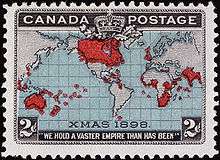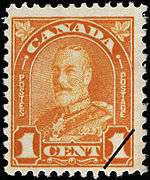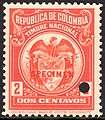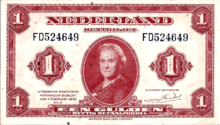American Bank Note Company
| Industry | Printing |
|---|---|
| Founded | 1795 (as Murray, Draper, Fairham & Company) |
| Headquarters | Fort Lee, New Jersey |
Key people |
Keith Goldstein, CEO US Operations Bud Kronenberg CEO Canadian Operations |
| Parent | ABNote North America |
| Website | Official website |


The American Bank Note Company was a major worldwide engraver of national currency and postage stamps. Currently it engraves and prints stock and bond certificates. It is based in Fort Lee, New Jersey.
Origins
Robert Scot, the first official engraver of the young U.S. Mint, began the company that would eventually grow into the nation’s premier high security engraving and printing firm, the American Bank Note Company.
Founded in 1795 as Murray, Draper, Fairham & Company (after Scot's three partners), the company prospered as the young United States population expanded and financial institutions blossomed. Its products included superior quality stock and bond certificates, paper currency for the nation’s thousands of state-chartered banks, postage stamps (from 1879 to 1894[1]), and a wide variety of other engraved and printed items.
After 1857
Following the Panic of 1857, seven of the nation’s most prominent security printers merged to form the American Bank Note Company on April 29, 1858. The new company made New York City its headquarters. Less than two years later, a handful of the remaining independent bank note printers merged to form the National Bank Note Company.
To be close to the stock exchanges, brokerage firms, and banks in lower Manhattan, the American Bank Note Company established its New York City headquarters in the Merchants Exchange Building at 55 Wall Street. The company moved its office and plant to 142 Broadway (at the corner of Liberty Street) in 1867, to another new facility at 78–86 Trinity Place in 1882, and again to 70 Broad Street in 1908.
The first paper currency was circulated by the US Treasury Department following the outbreak of the Civil War. Congress passed authorizing legislation for $60 million worth of these “Demand Notes” on July 17 and August 5, 1861. Under contract with the government, the novel paper money, called “greenbacks” by the public, was produced by the American Bank Note Co. and the National Bank Note Co. A total of 7.25 million notes were produced in denominations of $5, $10, and $20. In an interesting historical sidelight, American and National were also producing paper money for the Confederacy at the same time.
.jpg)

Following the initial production of U.S. currency by the government’s Bureau of Engraving and Printing in 1862, ABNCo sought a new source of demand for its services. They found it in foreign lands. The company would eventually go on to supply security paper and bank notes to 115 foreign countries.[2]
In 1877, pursuant to a law enacted by Congress, the U. S. Bureau of Engraving and Printing became the sole producer of all United States currency. The security printing industry, finding a good deal of its work had evaporated, accordingly underwent a second major consolidation in 1879, as American absorbed the National Bank Note and Continental Bank Note companies. At the time of the merger, Continental held the contract to produce U. S. Postage stamps, and this production continued under the American aegis.
In 1887, ABNCo won the second four-year contract to engrave and print Postal notes for the U.S. post office. (New York’s Homer Lee Bank Note Company produced these notes during the first contract period.) American assigned Thomas F. Morris, its Chief Designer, the task of re-designing this early money order. The paper for this contract (as for all Postal Notes and a massive number of official U.S. high security documents) was produced by Crane and Co. of Dalton, Massachusetts.
In 1891 the American Bank Note Company began producing a new form of money for a longtime customer: the American Express "Travelers Cheque." In its first year, American Express sold $9,120 worth of its new invention. During 2000, sales of American Express Traveler's Cheques totaled $24.6 billion.
In 1894, ABNCo completed the final contract for the private printing of American stamps. Perhaps their most popular stamps were the one cent to $5 issues commemorating the 1892–93 Columbian Exposition (for which they had also printed the admission tickets) in Chicago. On July 1, 1894 American delivered its entire stamp-producing operation to the U.S. Bureau of Engraving and Printing in Washington, D.C., where U.S. stamps were still printed up into the 1990s.
Twentieth Century
In 1943–44 American Bank Note Company was contracted by the United States government's Bureau of Engraving and Printing to produce the Overrun Countries series stamps.
ABnote Group
American Bank Note Company is a subsidiary of American Banknote Corporation and ABnote Group: http://abnote.com/
Today, following a variety of financial transformations, the American Banknote Corporation produces a wide variety of secure and official documents. With operations in Australia, New Zealand, United States, Canada, South Africa, Czech Republic, England and France, its products range from currencies and credit cards to passports, driver’s licenses, and birth certificates.
Building
The American Bank Note Company Building was built in 1908. The company sold it in 1988. It is listed on the U.S. National Register of Historic Places and is designated a New York City Landmark.
Gallery
-

Benjamin Franklin Issue of 1861 from the first series of US Postage Stamps produced by the National Bank Note Co (later called the American Bank Note Co.[1]
-
Beer revenue stamp proof single, 1871
-

Canadian penny stamp, 1898
-

1897 "Lady of the Light Bulbs" revenue stamp of Canada
-

Queen Victoria, Nova Scotia 8½ cent stamp, 1860
-

George V Canada 1 cent stamp, 1930
-

Pedro Álvares Cabral - steel engraving by American Bank Note Company
-

Colombia 1916 specimen revenue stamp
-

Greek bank note of 1912 for the NBG-Bank
-

U. S. Stamp from the "Overrun Countries series," showing the pre-1905 flag of Korea (similar to the modern flag of South Korea).
-

Dutch Guilder printed for the Dutch government-in-exile, 1943
- ^ Scott Specialized Catalogue of United States Stamps
See also
- Postage Stamp
- Postage stamps and postal history of the United States
- Bureau of Engraving and Printing
- New York Bank Note Company
- Homer Lee Bank Note Company
- Canadian Bank Note Company - Canadian unit from 1897 to 1923
References and sources
- References
- ↑ Two security printers absorbed into the ABN in 1879 produced U. S. Postage stamps between 1861 and that year: the National Bank Note Company (1861-73) and the Continental Banknote Company (1873-79
- ↑ Hessler, Gene (1993). The Engraver’s Line – An Encyclopedia of Paper Money & Postage Stamp Art. BNR Press. p. 19. ISBN 0-931960-36-3.
- Sources
- Antecedents of the American Bank Note Company of 1858 by Foster Wild Rice
- The Story of the American Bank Note Company by William H. Griffiths
- America’s Money America’s Story by Richard Doty
- The Comprehensive Catalog of U.S. Paper Money by Gene Hessler
External links
| Wikimedia Commons has media related to American Bank Note Company. |